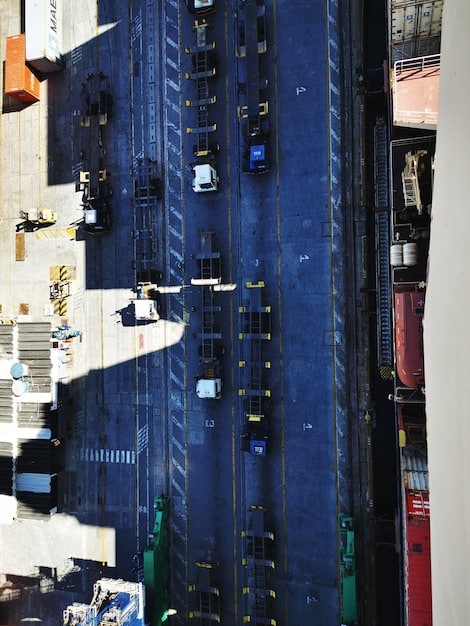Supply Chain Resilience: Building a Robust Strategy Against Future Disruptions

Advertisements
Supply chain resilience defines an organization’s capacity to anticipate, absorb, and adapt to disruptions, crucial for mitigating risks and ensuring continuous operations within today’s volatile global economy.
Advertisements
In an increasingly interconnected yet unpredictable world, businesses face an unprecedented array of challenges. From geopolitical tensions to climate events and technological shifts, the stability of global commerce is constantly tested. Ensuring Supply Chain Resilience: Building a Robust Strategy Against Future Disruptions is no longer just an operational consideration; it is a strategic imperative for survival and growth.
Understanding the Shifting Landscape of Supply Chain Risk
The global supply chain, once seen as a largely stable and predictable network, has revealed its inherent vulnerabilities in recent years. An evolving landscape of risks, from natural disasters to economic downturns and cyber incidents, demands a proactive approach rather than reactive measures. This section delves into the multifaceted nature of these risks and their profound impact on business operations worldwide.
Advertisements
Organizations must first recognize that the days of linear, predictable supply chains are over. Modern chains are complex webs of interconnected entities, where a disruption in one node can ripple across the entire network, creating unforeseen consequences. The challenge lies not only in identifying immediate threats but also in anticipating long-tail risks that may materialize years down the line.
Emerging Threats and Their Impact
Several factors now contribute to the volatility of supply chains. Understanding these key areas is the first step toward building genuine resilience. It’s not enough to simply react; businesses must develop a strategic foresight that allows them to prepare for the unexpected.
- Geopolitical Instability: Trade wars, sanctions, and regional conflicts can severely disrupt material flows, increase costs, and block access to critical markets or resources.
- Climate Change and Natural Disasters: Extreme weather events, such as floods, droughts, and unprecedented storms, directly impact logistics, production facilities, and resource availability, causing widespread delays and damage.
- Cybersecurity Risks: As supply chains become more digitized, they become more susceptible to cyberattacks that can compromise data, halt operations, and erode trust among partners.
- Economic Volatility: Inflation, recession, and sudden shifts in consumer demand can create whiplash effects, leading to inventory imbalances and stranded assets.
Beyond these, technological advancements, while offering immense opportunities, also introduce new avenues for disruption. The rapid pace of innovation means that what is cutting-edge today could be obsolete tomorrow, leaving businesses scrambling to adapt. Labor shortages, particularly in specialized fields like logistics and manufacturing, add another layer of complexity, making capacity planning incredibly challenging.
Effectively managing these risks requires a fundamental shift in strategy. It moves beyond simply identifying threats to understanding their interconnectedness and potential cascading effects. Businesses need to view risk not as an isolated incident but as part of a dynamic, interconnected system.
Key Pillars of a Robust Resilience Strategy
Building a resilient supply chain hinges on more than just reacting to crises; it requires a strategic, multifaceted approach that integrates foresight, adaptability, and collaboration. This section outlines the foundational pillars upon which organizations can construct a robust resilience strategy, moving from theoretical concepts to practical implementation.
A truly resilient supply chain is one that can not only withstand shocks but also emerge stronger, learning and adapting from each challenge. This involves a shift from efficiency-at-all-costs models to ones that prioritize flexibility and risk mitigation. It’s about building a system that is inherently antifragile, capable of gaining from disorder.
Pillar 1: Supply Chain Visibility and Transparency
You cannot manage what you cannot see. Enhanced visibility across every tier of the supply chain is paramount. This extends beyond immediate suppliers to their suppliers, and even to the source of raw materials. Transparency allows for early detection of potential issues and provides the data necessary for informed decision-making.
Technological solutions play a crucial role here, enabling real-time tracking of goods, monitoring of environmental factors, and precise data collection. Without a clear picture of operations from end to end, any resilience strategy will be built on shaky ground. It’s about creating a single source of truth across the entire network.
Pillar 2: Diversification and Redundancy
Over-reliance on a single supplier, location, or transportation mode creates critical points of failure. A core element of resilience is strategically diversifying sources and building redundancy into the network. This doesn’t necessarily mean duplicating every asset, but rather having credible, actionable alternatives.
- Multi-Sourcing: Engaging with multiple suppliers for critical components, even if it means slightly higher costs, significantly reduces risk.
- Geographic Diversification: Spreading production and storage facilities across different regions mitigates the impact of localized disruptions.
- Logistics Flexibility: Having access to alternative transportation routes and carriers ensures goods can still reach their destination even if primary channels are blocked.
This pillar is about deliberately designing a network that has multiple pathways and fail-safes. It acknowledges that disruptions are inevitable and pre-emptively builds in options for redirection and recovery. It’s an investment in stability over immediate cost savings.
Pillar 3: Agility and Adaptability
The ability to rapidly adjust to changing conditions is a hallmark of resilient supply chains. This involves flexible production capabilities, responsive inventory management, and a culture that embraces change rather than resists it. Agility is about shortening decision-making cycles and empowering teams to act quickly.
This includes having dynamic demand forecasting models, the capacity to rapidly reconfigure manufacturing lines, and a workforce trained to pivot swiftly to new tasks if required. An agile supply chain can quickly reallocate resources and redirect efforts in the face of unexpected events.
Implementing these pillars requires a holistic view of the supply chain, moving away from siloed departmental thinking. It demands cross-functional collaboration and a strategic commitment from top leadership to invest in measures that might not offer immediate ROI but provide invaluable long-term security. These components, working in concert, form the bedrock of true supply chain resilience.
Leveraging Technology for Enhanced Resilience
In the quest for supply chain resilience, technology emerges as an indispensable ally. It’s no longer just about automation; it’s about providing unprecedented levels of visibility, predictive analytics, and connectivity that empower organizations to anticipate and respond to disruptions with speed and precision. This section explores the transformative role of various technological innovations in bolstering supply chain robustness.
The digital transformation of supply chains is not a futuristic concept; it’s a current reality. Companies that embrace these tools gain a significant competitive advantage, moving beyond traditional, often reactive, approaches to supply chain management. Technology serves as the nervous system, providing essential intelligence and enabling coordinated action across complex networks.
Advanced Analytics and Predictive Modeling
Data is the new oil, and in supply chain resilience, robust analytics capabilities are the refinery. By leveraging big data, machine learning, and artificial intelligence, businesses can move from historical analysis to predictive insights. This allows for the forecasting of potential disruptions before they fully materialize.
Predictive models can analyze vast datasets, including weather patterns, geopolitical news, economic indicators, and historical disruption events, to identify probabilistic risks. This enables proactive inventory adjustments, alternative sourcing plans, and pre-positioning of resources, significantly reducing response times and mitigating impact.
Blockchain for Transparency and Trust
The distributed ledger technology of blockchain offers unique benefits for supply chain transparency and integrity. By creating an immutable, shared record of transactions and product movements, blockchain can provide unparalleled traceability from origin to consumer.
- Enhanced Traceability: Track products at every stage, verifying authenticity and origins, crucial for quality control and compliance.
- Improved Trust: All participants have access to the same, verified information, reducing disputes and improving collaboration.
- Risk Mitigation: Quickly identify where contaminated or compromised goods are in the supply chain, enabling rapid recalls or containment.
While still maturing in widespread adoption, blockchain’s potential for creating a verifiable and transparent supply chain is immense. It builds a foundation of trust that can expedite resolution during times of crisis and ensure accountability.

Internet of Things (IoT) for Real-time Monitoring
IoT devices embedded in products, vehicles, and warehouses provide real-time data on location, environmental conditions (temperature, humidity), and operational status. This constant flow of information offers granular visibility that was previously impossible.
For example, IoT sensors can alert companies to temperature deviations in perishable goods during transit or notify them of unexpected delays caused by traffic or equipment malfunction. This allows for immediate intervention, preventing spoilage or rerouting shipments to avoid bottlenecks. The ability to monitor conditions in real-time transforms reactive problem-solving into proactive issue management.
Integrating these technologies requires significant investment and strategic planning, but the payoff in enhanced resilience and improved operational efficiency is substantial. As supply chains become more complex, reliance on sophisticated technological tools shifts from being an advantage to a fundamental necessity.
The Role of Collaboration and Partnerships
Beyond internal capabilities and technological advancements, the strength of a supply chain’s resilience often lies in the quality and depth of its external relationships. Collaboration with suppliers, customers, and even competitors can transform individual vulnerabilities into collective strengths. This section explores how strategic partnerships and robust communication channels become critical components of a resilient supply chain ecosystem.
In an interconnected world, no single entity operates in isolation. Disruptions resonate throughout the entire network, underscoring the need for a collaborative approach. Moving past transactional relationships to foster genuine partnerships built on trust and shared objectives is paramount. It’s about creating a community of stakeholders committed to collective success.
Strengthening Supplier Relationships
Your suppliers are an extension of your own operations, and their stability directly impacts yours. Building strong, transparent relationships with key suppliers, especially those providing critical raw materials or components, is vital. This involves open communication, shared risk assessments, and sometimes, even co-investment in resilience measures.
Rather than simply dictating terms, businesses should engage in collaborative planning, sharing forecasts and potential future requirements. This enables suppliers to plan their capacities and address potential bottlenecks proactively. Fostering long-term partnerships reduces the likelihood of sudden disruptions due to supplier failure or changes in their strategic focus.
Cross-Industry Collaboration and Information Sharing
While competition remains a cornerstone of business, there are significant advantages to sharing non-competitive information and best practices within industries. Collaboration on common challenges, such as infrastructure vulnerabilities or emerging threats, can benefit all parties.
- Industry Forums: Participating in industry-specific groups to discuss common supply chain challenges and potential solutions.
- Information Sharing Agreements: Establishing protocols for sharing risk intelligence, such as early warnings of port congestion or raw material shortages.
- Joint Resilience Initiatives: Collaborating on pilot projects for new technologies or resilience strategies that benefit the entire ecosystem.
Such collaboration can lead to pooled resources for R&D, shared insights into emerging risks, and the development of industry-wide standards that enhance overall resilience. It recognizes that some risks are systemic and require a collective response.
Customer Engagement and Demand Management
Customers are an often-overlooked but crucial part of the supply chain. Open communication with customers about potential delays or changes can manage expectations and build trust. Understanding their evolving demands and anticipating shifts are critical for effective inventory and production planning.
Collaborative forecasting with key customers can reduce demand volatility, leading to more stable production schedules and lower inventory holding costs. When disruptions occur, transparent dialogue can help them adapt their plans, reducing the ripple effect and maintaining long-term relationships.
Ultimately, a resilient supply chain is a network of resilient relationships. Investing in these partnerships builds a collective shock absorber, allowing the entire ecosystem to better withstand and recover from unforeseen events. It transforms individual vulnerabilities into shared strengths.
Implementing Risk Management and Contingency Planning
Even the most robust supply chain strategy cannot eliminate all risks. Therefore, comprehensive risk management and meticulous contingency planning are indispensable. This section details the systematic approach to identifying, assessing, and mitigating risks, ensuring that when disruptions strike, organizations are prepared to respond swiftly and effectively, minimizing impact and accelerating recovery.
Risk management is not a one-time event but a continuous cycle of identification, analysis, response, and monitoring. It’s about developing a proactive mindset that constantly scans the horizon for potential threats, transforming uncertainty into manageable scenarios. Contingency planning, in turn, translates these analyses into actionable blueprints for crisis situations.
Risk Identification and Assessment
The first step in effective risk management is a thorough and ongoing process of identifying potential vulnerabilities. This involves mapping the entire supply chain, from upstream suppliers to downstream customers, to pinpoint critical nodes and potential failure points. Both internal and external factors must be considered.
Once identified, risks must be assessed based on their likelihood of occurrence and the potential severity of their impact. Techniques such as Failure Mode and Effects Analysis (FMEA) or scenario planning can help prioritize risks, allocating resources to address the most critical vulnerabilities first. This process moves beyond anecdotal evidence to data-driven insights.
Developing Robust Contingency Plans
A contingency plan (or business continuity plan) is a detailed roadmap for responding to specific, identified risks. These plans should be dynamic, regularly reviewed, and tested. They outline precise steps for managing disruptions, ensuring continuity of operations, and minimizing financial and reputational damage.
- Alternative Sourcing Pathways: Pre-identified backup suppliers and alternative logistical routes ready for activation.
- Crisis Communication Protocols: Clear guidelines for communicating with stakeholders (customers, employees, suppliers, media) during a disruption.
- Emergency Inventory Strategies: Decisions on buffer stocks for critical components or finished goods, and pre-negotiated agreements for surge capacity.
Contingency plans should also address financial implications, outlining strategies for managing cash flow during periods of reduced revenue or increased costs. They must be practical, actionable, and understood by all relevant personnel, enabling rapid and coordinated responses.
Regular Testing and Review
A plan is only as good as its last test. Regular drills, simulations, and tabletop exercises are essential to validate contingency plans, identify weaknesses, and train personnel. These exercises reveal gaps in communication, resource allocation, or decision-making processes that might otherwise go unnoticed until a real crisis hits.
Post-disruption reviews are equally critical. Every incident, whether major or minor, provides valuable lessons. By conducting thorough post-mortems, organizations can refine their risk models, update their contingency plans, and embed newfound resilience capabilities into their operational DNA. This iterative process ensures continuous improvement and adaptation.
Ultimately, risk management and contingency planning are not about preventing every disruption, which is often impossible. Instead, they are about building the capacity to absorb shocks, adapt quickly, and recover efficiently, transforming potential disasters into manageable challenges that strengthen the supply chain over time.
Measuring and Sustaining Resilience over Time
Building a resilient supply chain is an ongoing journey, not a destination. To ensure its continued effectiveness, organizations must establish clear metrics for measuring resilience, continuously monitor their performance, and foster a culture of perpetual improvement. This section focuses on the critical aspects of tracking progress, adapting strategies, and embedding resilience into the organizational DNA for long-term sustainability.
Without quantifiable measures, resilience remains an abstract concept. Translating strategic objectives into actionable key performance indicators (KPIs) allows businesses to gauge their preparedness, identify areas for enhancement, and demonstrate the tangible value of their investments in resilience. It’s about data-driven decision-making, even in the abstract world of risk.
Key Performance Indicators (KPIs) for Resilience
Measuring resilience requires a combination of traditional supply chain metrics and new, more specific indicators. These KPIs should assess both the prevention capabilities and the recovery speed and efficiency.
- Supply Chain Downtime Due to Disruptions: Measures the total time operations are halted or severely impacted. Lower numbers indicate higher resilience.
- Time to Recover Critical Operations: The duration required to achieve acceptable operational levels after a disruption. Shorter times indicate greater agility.
- Supplier Reliability Index (SRI) under Stress: Assesses the performance of key suppliers during periods of market stress or internal disruptions.
- Cost of Disruption per Incident: Quantifies the financial impact of each disruption, accounting for lost revenue, increased costs, and reputational damage.
Beyond these, qualitative assessments, such as feedback from risk simulations or supplier evaluations of partnership strength, also provide valuable insights. The goal is to create a balanced scorecard that captures the multifaceted nature of resilience.

Continuous Improvement and Adaptation
The global environment is dynamic, and so too must be the supply chain resilience strategy. What worked today may not work tomorrow. Organizations must embed mechanisms for regular review, analysis, and adaptation. This means treating every disruption, whether internal or external, as a learning opportunity.
Implementing feedback loops from incident Post-Mortems, conducting annual resilience audits, and staying abreast of geopolitical and technological trends are crucial. Resilient organizations are those that continuously challenge their assumptions and proactively adjust their strategies based on new information and evolving risks. It’s a culture of perpetual learning and refinement.
Fostering a Culture of Resilience
Ultimately, resilience is not just a strategic framework or a set of technical tools; it is a mindset that must permeate every level of the organization. From executive leadership to front-line operational staff, everyone must understand their role in maintaining and enhancing supply chain robustness.
This involves training programs, incentives for risk identification and mitigation, and a leadership commitment to prioritizing resilience alongside traditional efficiency goals. When resilience becomes part of the organizational culture, it moves from being a reactive measure to a proactive, ingrained attribute, ensuring long-term sustainability and competitiveness in an unpredictable world.
FAQs: Supply Chain Resilience
▼
Supply chain resilience refers to an organization’s ability to resist, adapt to, and recover from disruptions. It encompasses the capacity to anticipate potential issues, withstand the impact of unforeseen events, and quickly restore operations to pre-disruption levels or even improve them. This proactive approach ensures business continuity and minimizes losses in volatile environments.
▼
In today’s globalized and interconnected economy, supply chains are highly susceptible to various disruptions—from natural disasters to geopolitical conflicts and cyberattacks. Resilience is crucial to safeguard against operational halts, financial losses, reputational damage, and loss of market share. It ensures consistent supply, meets customer demand, and maintains a competitive edge in volatile markets.
▼
A robust strategy typically involves enhanced visibility across the entire supply chain, diversification of suppliers and geographical locations, fostering agility through flexible operations, and implementing comprehensive risk management and contingency planning. Strong collaboration with partners and leveraging advanced technologies like AI and IoT are also critical pillars for long-term resilience.
▼
Technology significantly boosts resilience by providing real-time visibility, predictive analytics, and automated response capabilities. Tools like IoT sensors offer live tracking, AI and machine learning forecast disruptions, and blockchain ensures data transparency and traceability. These technologies enable rapid identification of issues, informed decision-making, and proactive mitigation, reducing the impact and duration of disruptions.
▼
Collaboration is fundamental to resilience, transforming a chain of individual entities into a cohesive, mutually supportive network. Strong relationships with suppliers, customers, and even industry peers facilitate information sharing, joint risk assessments, and coordinated responses during crises. This collective approach fosters trust, reduces overall vulnerabilities, and enables a more unified and effective recovery from disruptions.
| Key Point | Brief Description |
|---|---|
| 📊 Risk Mitigation | Proactively identify and prepare for potential disruptions. |
| ⚙️ Technological Integration | Leverage AI, IoT, and blockchain for visibility and prediction. |
| 🤝 Collaborative Networks | Build strong relationships with suppliers and partners. |
| 🔄 Continuous Improvement | Regularly test, review, and adapt resilience strategies. |
Conclusion
Building a robust supply chain resilience strategy is no longer an optional add-on but a fundamental pillar of modern business operations. The current global landscape dictates that organizations must move beyond traditional efficiency models to embrace approaches centered on adaptability, foresight, and strong partnerships. By understanding the evolving risk environment, strategically leveraging technology, fostering deep collaboration across the ecosystem, and meticulously planning for contingencies, businesses can transform potential vulnerabilities into sources of competitive advantage. The journey towards true resilience is continuous, demanding constant measurement, review, and a pervasive cultural commitment to preparedness. Ultimately, a resilient supply chain not only weathers the storm but also emerges stronger, more agile, and better positioned for sustained growth in an increasingly unpredictable world.





